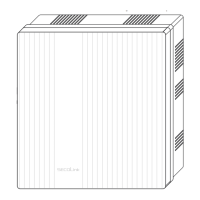SAFETY WARNINGS
Please act according to your local rules and do not dispose of your unusable alarm system or its components with other household waste. This product
utilization in EU is covered by European Directive 2002/96/EC.
The device must be installed in a place with limited access.
The device must be connected to AC power supply with Protective Earthing. Cable colors and purpose: Phase or Live line (L) - black or brown cable, Neutral
line (N) - blue cable, Protective Earth line (PE) - green cable with a vertical yellow stripe. Please use only double isolated cables with a cross-sectional area
2
of no less than 0,75 mm for the 230V power supply.
The device uses two power supplies: main and back-up.
2V, 7Ah/20HR capacity, rechargeable hermetically sealed Lead-Acid battery.
Main power supply: a power transformer with:
- primary winding: ~230V, 50 Hz;
- secondary winding: ~20V, 1.5A, 50Hz.
Back-up power supply: 1
SECOLINK intruder alarm system is compliant with EN 60950-1 safety requirements.
Power supplies described above must comply with the EN 60950-1 safety requirements.
All devices connected to the intruder alarm system (sirens, detectors, computer for programming, and etc.) must comply with EN 60950-1 safety requirements.
Additional automatic Two-Pole Circuit Breaker should be installed in AC electric power circuit in order to protect against over-current, short circuits, and earthing
faults.
The circuit breaker contact gap should be no less than 3mm, protective circuit breaker current must be in a 0,5A - 2A range.
The circuit breaker should be placed close to the system's housing and should be easily accessed.
Before performing any work of installation or service always disconnect the device from power supplies in sequence as described below:
- cut off the 230 V AC power line by turning off the automatic Two-pole Circuit Breaker;
- disconnect the 12V back-up battery by removing the female battery plug from male socket BAT.
Two-pole Circuit-Beaker installation on flexible cables is forbidden.
General safety requirements:
- do not touch any part of the main power supply under voltage such as a transformer, fuse block, or connection wires;
- it is forbidden to perform any device installation or service work during lightning;
- use batteries as per manufacturer’s recommendations. The use of improper battery type may cause an explosion;
- battery replacement : make sure that battery terminals are isolated; battery terminals short-wiring may cause an explosion.
It is not recommended to connect the device to a fully discharged battery. To avoid system malfunction use an adequate charger to charge a new or
discharged battery before connecting it to the device.
Inoperative or expired batteries should be recycled according to the local rules or EU directives 2006/66/EC and 93/86/EEC.
Collection and separate utilization of waste battery is mandatory!
Connection to the main supply must be made as per local authority rules and regulations.
The end of a stranded conductor shall not be consolidated by soft-soldering and insulated pins should be used instead. Insulated pins need to be connected in a proper
manner to remain mechanically efficient.
The PSTN communicator's PSTP terminals TIP, RING, T-1, R-1 should be connected to analog PSTN line. Connection to digital ISDN line may cause device
damage.
Device installation and service should be performed by trained personnel with sufficient knowledge about the device and general safety requirements to work with low
voltage (up to 1000V) AC power lines. In case of a device malfunction, repair works can only be performed by qualified personnel. If the system is malfunctioning, the
end user should inform qualified personnel as soon as possible. The user does not have permision to repair the system.
Alarm system modules come with a built-in LED indicator. LED blinks when the module is powered up. Press any key on the keypad to check if the system is powered
up or not. If the system was powered up, the keypad backlight will last for 30 seconds.
LAN800 and VIDNET are designed to be used together with a router which is placed in the same room or premises. It’s prohibited to connect LAN800 or VIDNET
directly to Wide Area Network (MAN, WAN) or building IT infrastructure cables.
Power supply distribution board
Automatic two-pole circuit
breaker
L N
N
L
Cable from a power
distribution board
Power cable to the
alarm system
Cabinet of the alarm system (device)
Picture 1. Automatic two-pole circuit breaker and a power cable wiring diagram
Page 1
General information
Control panels P16, P32, and P64 perform all necessary functions to protect apartments, offices, homes, or villas. It includes all PAS series capabilities and comes with
additional functions. The device is equipped with a reliable pulse-type power supply measurement, powerful siren control, failing battery disconnection, built-in
wireless module EXT116SVM, 2 wire smoke detector control circuitry, and an option to securely connect exchangeable communicators. It is designed to be operated
by keypads connected with a four-wire cable and is capable of being programmed by means of computer and software MASCAD in MS Window environment. More
information can be found at intruder alarm systems manufacturer's, Kodinis Raktas UAB, website http://www.secolink.eu/en/products/control-panels. Manufacturer
declares that products P16, P32, P64 comply with essential EU directives and EU standards EN 50131-1, Grade 1, Environmental Class II; EN 50131-3, EN 50131-6.
Intruder alarm system
Wiring manual
Control Panels P16, P32, P64

